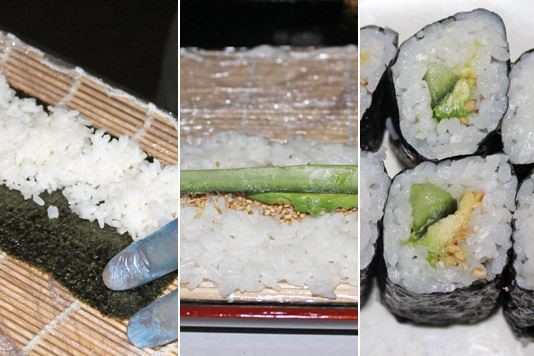
Ever tried making your own sushi? Elizabeth Ryan provides us with a history lesson and shows us how to make Maki rolls.
We are now a nation of sushi lovers, with ‘fast food sushi’ readily available on most high streets up and down the UK. But sushi is best when fresh, so roll out your sushi mat and get making your own – it’s far easier than it looks.
A brief history
Sushi originated in the 7th Century as a way of preserving fish. The fish was wrapped in fermented rice and kept for months, after which the latter was discarded. In 8th-century Japan there was a shift towards eating the rice, liberally sprinkled with vinegar, as well.
Sushi developed into an art form, with specialised chefs dedicating their whole lives to mastering the craft. From the early 19th Century sushi transformed into a food of convenience in Tokyo, made ready-to-eat and sold at market stalls. Sushi then made its way over to the US in the late 50s/early 60s and has grown in popularity around the western world since then.
Health benefits
Nutritional benefits include Omega-3 fatty acids from raw fish, iodine from seaweed, and digestive aids from ginger. These all contribute to a mineral-rich diet which has helped the Japanese achieve one of the highest life expectancies in the world. But although sushi can be a healthy option, it’s still made up of lots of white rice, sugar and salt. So like everything, it’s best eaten in moderation.
Rice
Making up 80% of sushi, the rice is considered to be more important than the fish or topping. The shorter the grain the better the rice, so restaurants prefer to use Japonica rice, which has a shorter grain than most and is sticky when cooked.
Preparation is key with sushi rice. The washing process is where people often go wrong. A traditional sushi chef spends the first four/five years of their apprenticeship just washing rice so that they understand its importance.
Follow these steps for cooking sushi rice:
- Rinse the rice in cold water until it drains off completely clear;
- Rest the rice in water (use slightly more water than rice) for at least 15 minutes, preferably longer, before cooking;
- Cook the rice in either a pan or a rice cooker for the time specified on the packet;
- While it’s cooking gently heat some rice vinegar with salt and sugar until it has dissolved (200ml rice vinegar, 4 tbsp sugar and 4 tsps of salt to 750g of uncooked rice);
- When the rice has cooked pour over the rice vinegar mixture and ‘cut it’ through with a wooden spatula to evenly distribute.
Fish
Sushi tastes vary all over the world. For instance in the UK about 75% of our sushi is made up of salmon, but in Japan their most popular fish is tuna. This is most likely due to the different types of tuna available. In the UK we use yellow-fin tuna but in Japan they use blue-fin, an extremely endangered breed, which has fattier, tastier flesh. White fish like brill and sea bream, as well as tempura prawns, are also popular sushi fillings/toppings.
A little bit of etiquette
The Japanese are renowned for their politeness, so it’s worth trying to emulate their good manners.
- Never rub your chopsticks together to get rid of splinters – this infers that your host is cheap.
- Soy sauce is intended to subtly highlight flavours in the sushi, so only pour out a very tiny amount into your dish.
- Never stick your chopsticks upright into a bowl of rice – it’s highly disrespectful. This is because it looks like incense sticks in a funeral urn.
- With sushi everything should be in moderation, so don’t pig out.
What you need
Because sushi is mainstream now, everything you need to make your own is available from large supermarkets. You will need:
- A bamboo rolling mat;
- Nori (black seaweed sheets);
- Sushi rice;
- Rice vinegar (preferably sushi vinegar);
- Sugar and salt (for seasoning the rice);
- Fresh fish: salmon or tuna;
- Vegetables: cucumber and avocado cut into strips;
- Wasabi paste, soy sauce and gari (pickled ginger).
Time to make Maki
The dish that we most associate with sushi is Maki. It’s actually very simple to make, but looks impressive. I learnt how to do it recently at a class hosted by K10, a modern Japanese restaurant in London’s Liverpool Street, as part of Broadgate's 'spring into health' initiative.
Sushi is best eaten straight away while it’s really fresh, but if you’re making it in advance then refrigerate as soon as possible. I would suggest watching a few YouTube videos on sushi-making before giving it a go.
What’s your favourite type of sushi? Or do you have any great tips for making sushi at home? Leave a Comment in the box below.
This is a classic lovefood article
You might also like
How to make a proper cup of tea